Seamless Content Management with OpenOffice and Cocoon
Christian Egli
1.0
Permission is granted to copy, distribute and/or modify
this document under the terms of the GNU Free Documentation
License, Version 1.1 or any later version published by the Free
Software Foundation; with no Invariant Sections, no Front-Cover
Texts and no Back-Cover Texts.
XML is establishing itself as the universal content
format. Not only is it widely used in web publishing but it is also
becoming the lingua franca for office tools such as OpenOffice.org and
future versions of Microsoft Office.
For the purpose of publishing content from a single XML
source to multiple output formats, Apache Cocoon is an excellent
tool. It provides powerful and flexible mechanisms to publish XML
content in almost any format.
Although there are many tools to aid in the creation of XML content
this task is still hard. What the user wants is not an XML editor
where she inserts elements. No, what she really wants is a WYSIWYG
tool that is integrated in the office environment (and still provides
all the benefits of validation, separation of content and presentation,
etc.). Yes, there are browser-based solutions that work quite well,
but none of them match the maturity and wide acceptance of an office
suite.
That's where OpenOffice.org comes to the rescue. OpenOffice.org is a
widely used open source cross-platform office suite which uses XML as
the native file format for all its documents. The format is documented
and open.
Combining OpenOffice.org and Apache Cocoon provides us with
a powerful tool chain for creating and publishing content. If we add
WebDAV to the mix, we also get distributed content authoring.
This paper will present the tools outlined and give a brief
overview of the history and fundamental concepts behind them. A
possible implementation of the combination will be presented and
directions for further exploration outlined.
Problem
Historically, content has been produced in conjunction with
presentation, i.e. content is tightly coupled with
presentation. Probably the best known example of this practice is HTML
where tables are typically used for layout and the content is usually
littered with font and other presentational attributes. Other examples
include Microsoft Word.
While this might be a easy and convenient solution, it does
not scale to today's demands where the same content is to be published
in numerous formats, e.g. plain HTML page, printer friendly HTML page,
possibly PDF, maybe RSS.
Separate content from presentation
The obvious solution to this problem is to separate
content from presentation. When we do this we end up with a
document containing the pure content and any number of separate
transformation descriptions for each particular presentation. A
transformation description for a book would for example outline
where to put page numbers and page breaks, whereas a
transformation description for a web page might specify where to
put banner ads or navigational elements.
To produce a particular presentation, for example HTML, we
simply take the content and apply the transformations as they are
described in the transformation descriptions for the HTML
presentation. This allows us to produce any presentational format
from one single content source as shown in Figure 1.
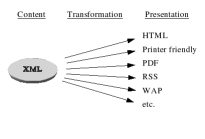
Enabling technology
XML, XSLT and other World Wide Web Consortium (W3C)
standards have established themselves as key enabling technologies
to achieve the separation of content and presentation and provide an
easy and standard transformation mechanism between content and
presentation.
XML (eXtensible Markup Language) is a standard based on
SGML and is increasingly being used as the universal,
presentation-free content format. It lends itself perfectly for
media-independent publishing and data interchange. It is widely
used in web publishing and is also becoming the lingua franca for
office tools such as OpenOffice.org and future versions of
Microsoft Office.
XSLT (Extensible Stylesheet Language Transformations) is a
language for transforming XML documents. It allows transformation of
one XML format into another (e.g. XHTML, RSS) or into any other
text-based format as illustrated in Figure 2.

Apache Cocoon
Apache Cocoon is a highly flexible open-source web
publishing framework that is based on XML and XSLT. One of the
fundamental concepts is the XML pipeline, where XML data is passed
between the components. An example of a very basic pipeline is shown
in Figure 3. The first component, a so-called generator, produces an
XML stream from a file, a database or other sources. The XML is then
piped into a transformer which manipulates it, usually by applying an
XSL transformation to it. Finally, the XML data is passed to a
serializer which converts the XML stream into the format required by
the requesting client, e.g. HTML, PDF, JPEG, etc. Figure 3 illustrates
not only the concept of the Cocoon pipeline, but also shows how Cocoon
supports separation of content and presentation in a very
straight-forward way.
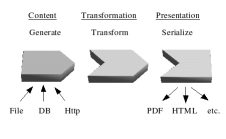
The concept of transformation from single content to
multiple presentation as depicted in Figure 2 maps directly to the
Cocoon concept of pipelines. Each arrow in Figure 2 symbolizes a
transformation of the content to a particular presentation. In Cocoon
this translates to multiple pipelines where the corresponding
transformation for each presentation is applied as can be seen in
Figure 4.
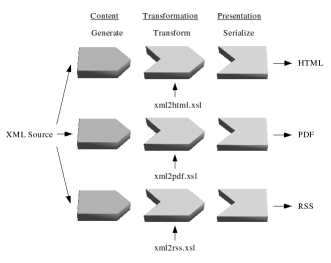
Example
The pipelines in Cocoon are defined in the so-called sitemap which
itself is an XML file. The following snippet from a sitemap shows
the pipelines as they correspond to Figure 4:
<map:pipeline>
<map:match pattern="simple.html">
<map:generate src="simple.xml"/>
<map:transform src="xml2html.xsl"/>
<map:serialize type="html"/>
</map:match>
<map:match pattern="simple.pdf">
<map:generate src="simple.xml"/>
<map:transform src="xml2pdf.xsl"/>
<map:serialize type="fo2pdf"/>
</map:match>
<map:match pattern="simple.rss">
<map:generate src="simple.xml"/>
<map:transform src="xml2rss.xsl"/>
<map:serialize type="xml"/>
</map:match>
</map:pipeline>
|
Cocoon uses the concept of matchers. For each request
Cocoon determines which pipeline ought to be used to handle it. In the
example above very simple pattern matchers are used. The request
for "simple.html" is obviously handled by the first pipeline
which delivers HTML since the request exactly matches the
pattern of the matcher. Requests for "simple.pdf" and
"simple.rss" are handled accordingly.
Content Creation
We have seen how Cocoon can help with publishing XML
content. However, when it comes to creating the content, we are faced
with editing XML. Although it is human-readable, it is not something
that people beyond the command-line and vi/Emacs crowd are willing to
look at. The majority of users are used to producing content with
WYSIWYG "Office Applications". They also expect their content
production tools to be integrated seamlessly in the desktop so that
features like drag-and-drop just work.
As it happens, OpenOffice.org, a free multi-platform office
productivity suite, uses XML as its native file format.
Would it be possible to combine OpenOffice.org for content
creation and Cocoon for content publication?
OpenOffice.org
There is hardly a need to introduce OpenOffice.org. It
includes the key desktop applications, such as a word processor,
spreadsheet, presentation manager, and drawing program, with a user
interface and feature set similar to other office suites'.
Since its native file format is XML, open and very well
documented, OpenOffice.org lends itself to being a major player in the
XML publishing tool chain as shown in the conceptional overview in
Figure 5.
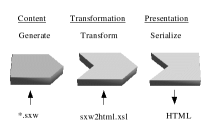
As in to Figure 3, Figure 5 also shows a pipeline with
an XML file, in this case an OpenOffice.org file (*.swx), at the
beginning. To produce HTML, an XSL transformation is applied to
this XML and finally it is serialized as HTML.
The actual implementation of the publishing process is not
as straight-forward as the conceptional overview suggests. The
OpenOffice.org file is actually a zip file containing multiple XML
files, and possibly other files such as images in JPEG or GIF
format. In order to feed the Cocoon pipeline one of the XML files
(content.xml) is extracted from the zip file
and forwarded for XSL transformation. For the technical details of
the actual implementation please refer to the descriptions in the
appendix.
WebDAV
XML publishing, especially when it comes to web publishing,
is typically regarded as a task that is handled on the server. On the
other hand, content creation is typically done on a desktop machine. To
achieve the touted seamless integration we need to find a way to make
this distinction transparent.
The ideal solution for this is WebDAV (Web-based Distributed
Authoring and Versioning). WebDAV provides a set of extensions to the
HTTP protocol which allows users to edit and manage files on remote
web servers collaboratively.
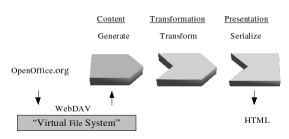
This solution allows content creators to edit their content
with OpenOffice.org and seemingly store it on their desktop
machine. In reality, of course, it stored on the server from where
it can be served by Cocoon in multiple output formats.
There is more to Content Management
While we have shown that the combination of OpenOffice.org
and Cocoon can provide a solution for the needs of content creation
and delivery, the combination lacks support for another crucial part
of content management as defined in the feature list of OSCOM, the
organization for open source content management: the management proper
of the content. Content management includes aspects such as workflow,
access control, versioning (e.g. scheduling, expiration),
personalization and localization.
Some of these features, like access control can be provided
by WebDAV. Others, such as versioning, will be provided by WebDAV in
the future. Personalization and localization can be partially handled
by Cocoon, but these features don't cover the whole range of
requirements as specified by OSCOM.
The real answer is of course to use a proper Content
Management System. The ideal would be a Cocoon-based solution which
would allow us to leverage its XML publishing strengths. A number of
up and coming contenders hope to fill the role of a Cocoon-based
Content Management System. One of the most promising candidates,
Apache Lenya, has just recently been accepted as an official Apache
subproject .
Conclusion
We have seen that OpenOffice.org and Cocoon can complement
each other in providing a powerful solution for content creation and
delivery in multiple presentations.
WebDAV can enhance this by providing transparent access to
content on remote servers.
More work is needed in the area of content management proper
when it comes to versioning, access control and workflow. Some of
these needs can be handled by WebDAV and additions to Cocoon, but to
provide the full range of features for what is generally called
"content management", this is not enough.
The current choices available for the content publisher are:
-
to use a "real" Content Management System (CMS) which
has features like workflow and localization. Currently, however, there
is no full-fledged CMS based on Cocoon so some of the major benefits
like content-presentation separation and multi-presentation delivery
might not be provided by the "real" CMS.
-
to wait for WebDAV to deliver on its promises to
standardize and implement versioning, configuration management and
access control.
-
to use one of the up and coming Cocoon-based CMS like
Apache Lenya.
Anhang: Appendix
Prerequisites
In order to be able to publish OpenOffice.org documents
with Cocoon the following prerequisites have to be met:
-
OpenOffice.org DTD
The DTDs for OpenOffice documents have to be installed
on the system. They can be found in the local OpenOffice.org
installation.
-
XML Catalog
In order for Cocoon to find the DTDs an XML catalog
has to be setup. The
CatalogManager.properties file has to
be edited for Cocoon to know about this new XML catalog.
-
OpenOffice2HTML XSLT
In order to render the OpenOffice XML as HTML, the XSL
transformation file has to be installed where Cocoon can find
it. A very good XSLT which is fairly complete can be
fetched from zope.org (http://www.zope.org/Members/philikon/ZooDocument).
Cocoon Pipelines
The following describes the pipelines that have to be set
up in order to be able to serve OpenOffice.org documents with
Cocoon.
-
Read the zip/jar file
A very simple pipeline is needed which basically just
reads the OpenOffice document and returns it as is.
<map:match pattern="**.sxw">
<map:read src="content/{1}.sxw"/>
</map:match>
|
-
Unpack zip file and transform the OpenOffice.org XML
to HTML
OpenOffice.org documents are zip files containing XML
files for content and style plus optionally additional files such as
JPEG or PNG. The actual content is contained in a file named
content.xml. In order to present the
OpenOffice.org document Cocoon has to unpack the zip file, extract the
content.xml file and apply the XSL transformation
to render it as HTML
Zip is the same file format as jar. Java supports jar
unpacking natively with the jar protocol. The pipeline which reads the
jar file, extracts the content and applies the transformation, looks
as follows:
<map:match pattern="**.oo">
<map:generate src="jar:http://localhost:8080/{1}.sxw!/content.xml"/>
<map:transform src="xslt/ooo2html.xsl"/>
<map:serialize/>
</map:match>
|
|
